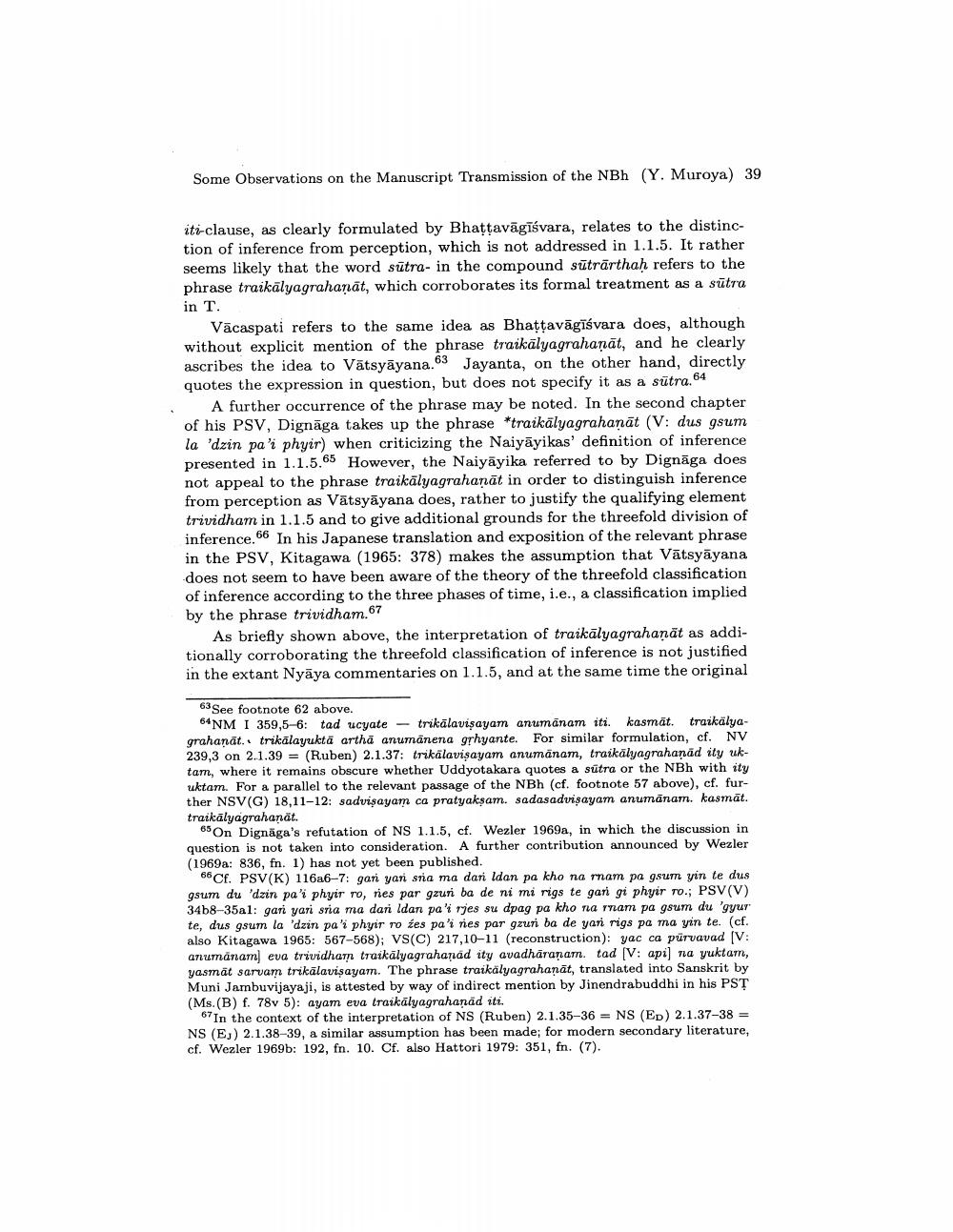________________
Some Observations on the Manuscript Transmission of the NBh (Y. Muroya) 39
iti-clause, as clearly formulated by Bhattavāgīśvara, relates to the distinction of inference from perception, which is not addressed in 1.1.5. It rather seems likely that the word sutra- in the compound sutrārthaḥ refers to the phrase traikālyagrahaņāt, which corroborates its formal treatment as a sutra in T.
Vācaspati refers to the same idea as Bhattavāgīśvara does, although without explicit mention of the phrase traikālyagrahaņāt, and he clearly ascribes the idea to Vātsyāyana.63 Jayanta, on the other hand, directly quotes the expression in question, but does not specify it as a sūtra.64
A further occurrence of the phrase may be noted. In the second chapter of his PSV, Dignāga takes up the phrase *traikalyagrahanāt (V: dus gsum la 'dzin pa'i phyir) when criticizing the Naiyāyikas' definition of inference presented in 1.1.5.65 However, the Naiyāyika referred to by Dignāga does not appeal to the phrase traikālyagrahanāt in order to distinguish inference from perception as Vätsyāyana does, rather to justify the qualifying element trividham in 1.1.5 and to give additional grounds for the threefold division of inference.66 In his Japanese translation and exposition of the relevant phrase in the PSV, Kitagawa (1965: 378) makes the assumption that Vātsyāyana does not seem to have been aware of the theory of the threefold classification of inference according to the three phases of time, i.e., a classification implied by the phrase trividham.67
As briefly shown above, the interpretation of traikālyagrahaņāt as additionally corroborating the threefold classification of inference is not justified in the extant Nyāya commentaries on 1.1.5, and at the same time the original
63 See footnote 62 above.
**NM I 359,5-6: tad ucyate - trikālavisayam anumānam iti. kasmät. traikalyagrahaņāt.. trikālayukta artha anumanena grhyante. For similar formulation, cf. NV 239,3 on 2.1.39 = (Ruben) 2.1.37: trikalavisayam anumanam, traikalyagrahanād ity uktam, where it remains obscure whether Uddyotakara quotes a sútra or the NBh with ity uktam. For a parallel to the relevant passage of the NBh (cf. footnote 57 above), cf. further NSV(G) 18,11-12: sadvisayam ca pratyaksam. sadasadvisayam anumanam. kasmát. traikālyagrahanät.
65 On Dignāga's refutation of NS 1.1.5, cf. Wezler 1969a, in which the discussion in question is not taken into consideration. A further contribution announced by Wezler (1969a: 836, fn. 1) has not yet been published.
66 CE. PSV(K) 116a6-7: gari yari sria ma dari ldan pa kho na mam pa gsum yin te dus gsum du 'dzin pa'i phyir to, res par gzun ba de ni mi rigs te gari gi phyir to.; PSV(V) 34b8-35al: gari yari sria ma dari ldan pa'i rjes su dpag pa kho na ruam pa gsum du 'gyur te, dus gsum la 'dzin pa'i phyir ro íes pa'i res par gzuri ba de yar rigs pa ma yin te. (cf. also Kitagawa 1965: 567-568); VS(C) 217,10-11 (reconstruction): yac ca pürvavad (V: anumanam eva trividham traikālyagrahaņād ity avadhāraṇam, tad [V: api) na yuktam, yasmāt sarvam trikālavisayam. The phrase traikälyagrahanāt, translated into Sanskrit by Muni Jambuvijayaji, is attested by way of indirect mention by Jinendrabuddhi in his PST (Ms.(B) f. 78v 5): ayam eva traikālyagrahanād iti.
In the context of the interpretation of NS (Ruben) 2.1.35-36 = NS (ED) 2.1.37-38 = NS (EJ) 2.1.38-39, a similar assumption has been made; for modern secondary literature, cf. Wezler 1969b: 192, fn. 10. Cf. also Hattori 1979: 351, fn. (7).




